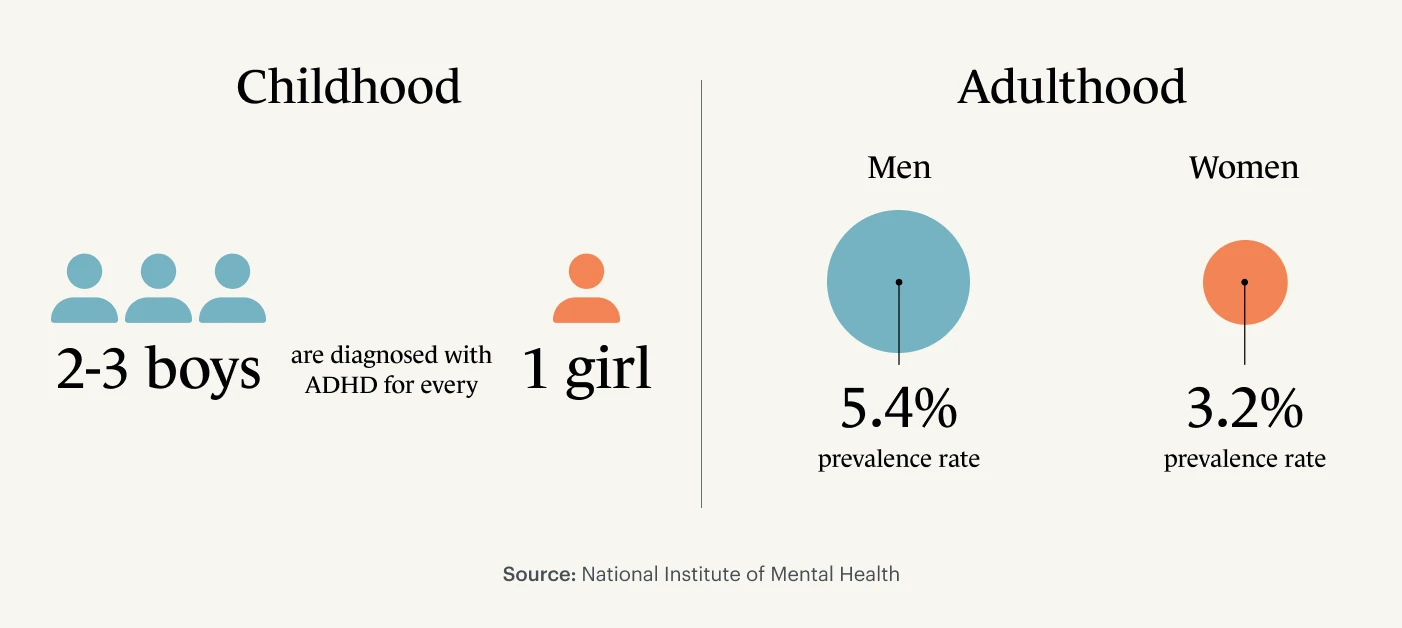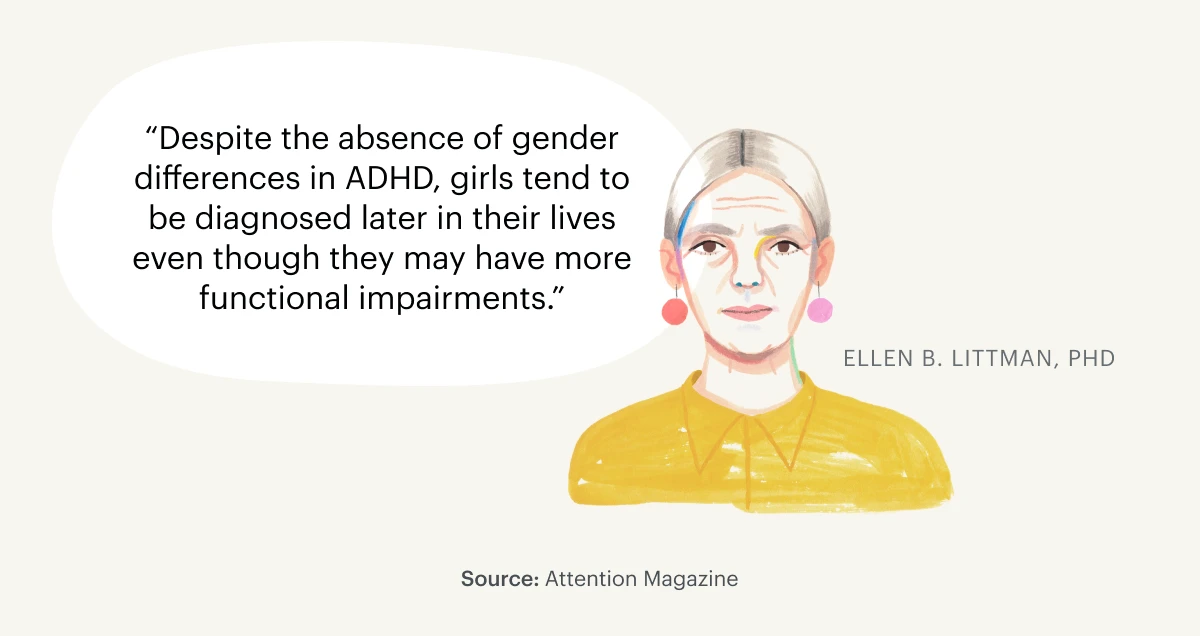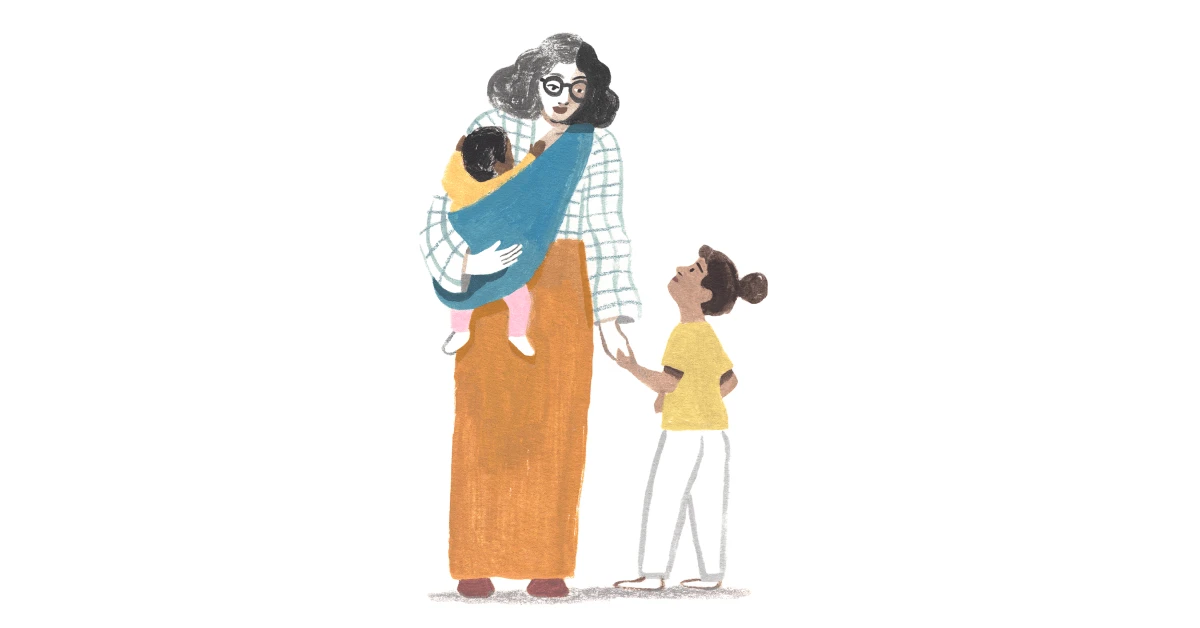It’s only during the past 25 years that doctors and mental health experts began to understand the gender differences in ADHD symptoms in women and girls, as compared to men and boys.
In the 1990s and earlier, people believed ADHD—attention deficit hyperactivity disorder—primarily affected young boys.
Back then, mental health professionals and doctors assumed ADHD disappeared with age as kids grew up and grew out of it, as Children and Adults with Attention-Deficit Hyperactivity Disorder (CHADD) points out.
“Girls tend to be diagnosed later in their lives, even though they may have more functional impairments [than boys].”
—Dr. Ellen Littman, Ph.D.
Over the past 20 years, however, mental health professionals recognized ADHD as a chronic disorder that persists into adulthood in many cases.
As mental health professionals’ understanding of the disorder evolved, the number of Americans diagnosed with ADHD increased.
According to the Centers for Disease Control (CDC) QuickStats, the percentage of U.S. children diagnosed with ADHD increased by 42% between 2003 and 2011—from 8% to 11% of all kids.
Girls often fail to demonstrate classic hyperactive symptoms.
When we account for both children and adults diagnosed with ADHD, nearly 30 million Americans are living with ADHD.
That’s almost one out of every ten Americans.
But, the diagnoses aren’t evenly distributed between the genders, and there are some nuanced reasons contributing to this, which we’ll examine below in more detail.

First, what percentage of girls and women are diagnosed with ADHD?
As of Centers for Disease Control (CDC) 2016 data, approximately three boys are diagnosed with ADHD for every girl.
Even today, the myth that ADHD is a “boys’ disorder” persists among many parents, teachers—and even doctors and mental health experts who may have received their training over 20 years ago, when the official diagnosis criteria for ADHD was different.
Entrenched gender biases continue to impede girls’ diagnoses, according to an August 2021 article in Attention Magazine by clinical psychologist Dr. Ellen B, Littman, Ph.D.
“Girls tend to be diagnosed later in their lives, even though they may have more functional impairments,” says Littman.
A 2018 original investigation found that between 1997-2016, the rate of ADHD diagnosis doubled in American girls, although the percentage of girls diagnosed still lag behind boys overall.
“Girls and women with ADHD tend to internalize their symptoms while boys and men tend to externalize them.”
Another 2013 study refers to reasons why girls may be consistently underidentified and underdiagnosed.
Girls often fail to demonstrate classic hyperactive symptoms, point out the study’s authors.
Similarly, 2008 research published mentioned gender bias in ADHD diagnosis, pointing out that females with ADHD are less likely to be referred for treatment than males with ADHD.
Researcher and clinical psychology professor at the University of Canterbury, Dr. Julia Rucklidge, Ph.D, who co-authored 2021’s The Better Brain: Overcome Anxiety, Combat Depression, and Reduce ADHD and Stress with Nutrition says boys are more likely to exhibit externalized symptoms (running and impulsivity) while girls exhibit internalized symptoms (inattentiveness and low self-esteem).
“We’re more likely to see females daydream—they can be misdiagnosed with anxiety or depression or labeled as ‘underachievers.’”
Rucklidge concluded in 2008, “Future research should include equal representation of both sexes.”
Among adults, the National Institute of Mental Health (NIMH) finds the overall prevalence of ADHD in 5% of American men and 3% of American women.
However, particularly for girls and adult women, many American mental health professionals report that the true numbers are actually much higher.

There are 3 main types of ADHD—attention deficit hyperactivity disorder
As CHADD points out, in 1994 the American Psychological Association APA Diagnostic and Statistical Manual, fourth edition (DSM-4) refined the diagnosis of ADHD to list three different types of ADHD: inattentive type, hyperactive/impulsive type, and combined type.
The 2013 Diagnostic and Statistical Manual, fifth edition (DSM-5) went a step further and described the different forms of ADHD as “presentations,” rather than types—indicating that ADHD can change in how it looks and presents during the course of a person’s life.
1. Predominantly inattentive and distractible ADHD
Adults and children with the predominantly inattentive presentation of ADHD might be disorganized, leave tasks and projects unfinished, not pay attention to detail, find it hard to follow conversations or instructions, and forget details of daily routines.
According to the DSM-5, children up to age 16 need to present six or more of these symptoms, and teens and adults age 17 and older need to present five or more of these symptoms.
What’s more, 5 or 6 of these symptoms need to have been present for at least 6 months:
Often fails to give close attention to details or makes careless mistakes at work, in schoolwork, or with other activities
Often has trouble holding attention on tasks or play activities
Often does not seem to listen when spoken to directly
Often does not follow through on instructions and fails to finish duties in the workplace, chores, or schoolwork (e.g., loses focus, side-tracked)
Often has trouble organizing tasks and activities
Often avoids, dislikes, or is reluctant to do tasks that require mental effort over a long period of time (such as in-depth work projects, schoolwork, or homework)
Often loses things necessary for tasks and activities (e.g. wallet, keys, eyeglasses, mobile phone, school materials, pencils, books, tools)
Is often easily distracted
Is often forgetful in daily activities
2. Predominantly hyperactive/impulsive ADHD
People with the hyperactive-impulsive presentation of ADHD might be excessively talkative, always in movement, restless, impulsive, have difficulty waiting their turn, interrupting others, speak at inappropriate times, and have more accidents and injuries than people without ADHD—or those with the primarily inattentive presentation.
As the DSM-5 points out, children up to age 16 need to present six or more of these symptoms, and teens and adults age 17 and older need to present five or more of these symptoms.
As above (with inattentive ADHD), 5 or 6 symptoms need to have been present for at least 6 months:
Often fidgets with or taps hands or feet, or squirms in their chair
Often leaves their chair in situations when remaining seated is expected
Adults and teens may feel restless. Children may run about or climb in situations where it is not appropriate
Often unable to play or take part in leisure activities quietly
Is often “on the go” acting as if “driven by a motor”
Often talks excessively
Often blurts out an answer before a question has been completed
Often has trouble waiting their turn
Often interrupts or intrudes on others (e.g. butts into conversations or games)
In addition to presenting 5 or 6 of the symptoms above, the following conditions must be met:
Several symptoms of inattentive or hyperactive-impulsive ADHD were present before age 12.
Several ADHD symptoms are present in two or more settings, such as at work, at school, with friends or relatives, and/or in other social and group activities.
There must be clear evidence that the symptoms interfere with—or reduce the quality of— social activities, work, or school functioning.
The symptoms are not better explained by another mental disorder, such as a mood disorder, anxiety disorder, dissociative disorder, or a personality disorder.
3. Combined presentation ADHD
Adults and children with this combined ADHD presentation have symptoms of both types of ADHD (inattention and distractibility), as well as impulsive and hyperactive behaviors.
If enough symptoms of both inattention and hyperactivity-impulsivity ADHD have been present for the past six months, then it’s considered combined type ADHD.

Are the signs and symptoms of ADHD different for females?
Psychotherapist, author, consultant and ADHD coach Terry Matlen, MSW, believes many women haven't been identified or adequately diagnosed.
“Girls and women with ADHD tend to internalize their symptoms while boys and men tend to externalize them,” explains Matlen.
Men and boys’ behaviors make ADHD much easier to spot, as they might fall into more outwardly aggressive or risk-taking behaviors.
“We’re more likely to see females daydream or become anxious or depressed—they can be misdiagnosed with an anxiety and/or depressive disorder or labeled as ‘underachievers,’” she says.
On the other hand, according to Matlen, men and boys’ behaviors make ADHD much easier to spot, as they might fall into more outwardly aggressive or risk-taking behaviors.
The following infographic and bulleted lists compare symptoms of ADHD in boys and girls, according to the Drake Institute of Neurophysical Medicine: Boys’ ADHD symptoms: Usually diagnosed with hyperactive-impulsive presentation
Impulsive
Overactive or rule-breaking behaviors
Inability to sit still
Excessive talking
Frequently interrupts others’ conversations or activities
May be overly attached to video games
Easily distracted
Girls’ ADHD symptoms:
Usually diagnosed with inattentive presentation ADHD
Academic underachiever
Daydreams
Has low self-esteem
May have anxiety and/or depression
Needs extra help with schoolwork
Seems like she is in her own world
Problems with executive functioning
Trouble listening

Why does ADHD present differently in women and girls?
A report published in Psychiatric Times found few reported sex differences in problem behavior during infancy and early childhood.
However, by around four years old, behavioral sex differences begin to appear. Boys start showing more aggressive and impulsive behaviors.
But why is that? Why aren’t the symptoms of ADHD similar in both genders?
In women and girls, ADHD tends to be seen, recognized, labeled, and misdiagnosed as anxiety and depression.
According to the report, there are two theories.
The first is the girls more often channel their problem behavior into internalizing behaviors.
In women and girls, ADHD tends to be seen, recognized, labeled, and misdiagnosed as anxiety and depression.
The second is that girls experience more rapid neurobiological, cognitive, motor, and social development.
With the onset of puberty, girls' ADHD symptoms accelerate due to increases in estrogen and dopamine receptors.
In the years before puberty, this rapid growth can mask or protect against the manifestation of some ADHD symptoms.
However, with the onset of puberty, symptoms of ADHD accelerate due to increases in estrogen and dopamine receptors.
Regardless of how differently symptoms present, having ADHD in either gender—especially when undiagnosed and untreated—increases detrimental and dangerous behaviors.
The risk of dropping out of school, underperformance at school and later at work, the use of tobacco or illicit drugs, engagement in antisocial behaviors, and difficulty making and maintaining friendships are all increased among people with ADHD.

What does inattention look like in adult women?
According to Matlen, women with ADHD frequently struggle with staying organized, as their lives become more and more complicated with career, social lives, and family obligations.
"A woman with ADHD often has to figure out care for her family and home, along with managing her work responsibilities and taking on the many social responsibilities that are often expected of adult women,” says Matlen. “She might also struggle with depression, anxiety, or addiction.”
Women with inattentive ADHD might be called lazy, because being sluggish and having low energy, makes it difficult for them to get things done.
Matlen, who has ADHD herself, explains that executive functioning problems often occur.
A woman with ADHD could find it challenging to get from point A to point B and then to point C.
She may be wondering how to parent a child with ADHD when she may have adult ADHD herself.
There may be piles of stuff at home and on her desk at work, making her feel incompetent.
Women with inattentive ADHD might be called lazy, because being sluggish and having low energy, makes it difficult for them to get things done.
There may be piles of stuff at home and on her desk at work, making her feel incompetent.
These problems can lead to low self-esteem when women with inattention harshly judge themselves for their perceived failures.
Untreated ADHD can have serious consequences.
Women with inattentive ADHD frequently have rich inner lives.
They're often drawn to quiet, creative endeavors like writing, drawing, painting, or playing musical instruments.
Take our 3-Minute Adult ADHD Test to find out whether you may have undiagnosed ADHD.
Damaging impacts of undiagnosed ADHD
Because ADHD so often goes undiagnosed—particularly with women's symptoms either not noticed or not taken seriously—many adult women have been living with ADHD their entire lives without being aware.
And untreated ADHD can have serious consequences.
Women who've grown up with undiagnosed ADHD are more likely to have an anxiety disorder or depression, than those without ADHD.
According to the Anxiety and Depression Association of America (ADAA), about 50 percent of adults with ADHD also suffer from an anxiety disorder.
Women who've grown up with undiagnosed ADHD are more likely to have an anxiety disorder or depression, than those without ADHD.
The ADAA points out that adult ADHD symptoms that coexist with an anxiety disorder may significantly impair an individual's ability to function.
A 2014 review of research found evidence to suggest that ADHD is associated with lower self-esteem in adulthood, and that these self-esteem issues can be remedied (at least somewhat), by psychotherapy. Women living with undiagnosed ADHD may also develop low self-esteem, from years of believing and judging themselves harshly for forgetfulness and disorganization.
What's more, a 2018 review of research also suggests ADHD greatly elevates risk for substance use and misuse, including tobacco, alcohol, marijuana, cocaine, and LSD.
Women living with undiagnosed ADHD may also develop low self-esteem, from years of believing and judging themselves harshly for forgetfulness and disorganization.
The authors of the paper point out that substance use may be considered a form of self-medication for patients with ADHD.
A final negative consequence of untreated ADHD is that it may contribute to a shortened life expectancy as a result of impaired decision-making and increased impulsivity that are often symptoms of the disorder.
Online adult ADHD test
Take our 3-Minute Adult ADHD Test to see if you could benefit from talking with your doctor, therapist, or psychologist about diagnosis and treatment.
Choose to discuss with a therapist who specializes in diagnosing and treating ADHD, many with online availability and free initial 15-minute consultations.
How to find a therapist for ADHD diagnosis and support
If your symptoms interfere with completing daily tasks, it’s time to seek help.
You might find the problems come from disorganization, feeling sluggish, anxiety, or depression.
It doesn’t matter why you’re struggling—it only matters that you’re struggling.
Primary care physicians, psychologists, psychiatrists, and neurologists can diagnose ADHD.
Many people feel most comfortable starting with their primary care physician, especially if this is someone you have developed a relationship with over the years.
The first step is a physical examination to rule out any physical causes for your symptoms.
Some primary physicians feel comfortable assessing, diagnosing, and treating ADHD.
Others will refer you to a mental health provider, such as a therapist, clinical psychologist, or psychiatrist.
The Monarch Directory by SimplePractice makes it easy for you to find mental health professionals who specialize in diagnosing and treating ADHD.

You may also want to consider therapists experienced with cognitive behavioral therapy (CBT). According to CHADD, research shows cognitive behavioral therapy (CBT) can benefit adults with ADHD—whether or not they're being treated with medication.
Research shows cognitive behavioral therapy (CBT) can benefit adults with ADHD—whether or not they're being treated with medication.
On Monarch, you can find licensed therapists nationwide and choose to browse therapists and counselors who accept your insurance.
There's also transparency about the cost of therapy. When you view an individual provider’s page, directly below their areas of specialty you’ll see their fees per session and which insurance providers they accept.
Many therapists listed on Monarch also allow you to book free 15-minute initial consultation appointments.
READ NEXT: Why Do So Many People Seem to Suddenly Have ADHD?
Need to find a therapist who specializes in ADHD? Check out the Monarch Directory by SimplePractice to find licensed mental health therapists near you specializing in ADHD with availability and online booking.
About the author: Eileen Bailey is a freelance writer and award-winning author. She has 25 years of experience writing on physical and mental health, emotional wellbeing, and parenting. Some of her books include Earn It: What to Do When Your Kid Needs an Entitlement Intervention, What Went Right: Reframe Your Thinking for a Happier Now, and The Complete Idiot’s Guide to: Adult ADHD.




